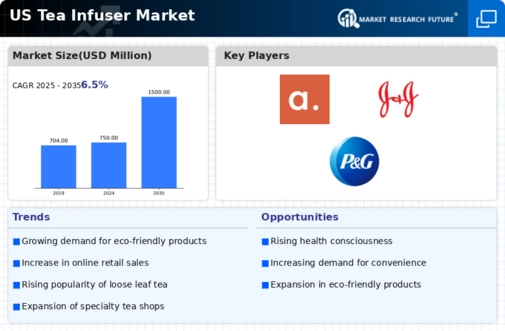E-commerce Growth and Online Retailing
The tea infuser market is witnessing a transformation due to the rapid growth of e-commerce and online retailing. Consumers are increasingly turning to online platforms for their tea-related purchases, including infusers, due to the convenience and variety offered. This shift is reflected in market data, which shows that online sales of tea products have surged by approximately 40% in recent years. The tea infuser market is likely to benefit from this trend, as brands enhance their online presence and offer exclusive products through e-commerce channels. Additionally, the ability to access customer reviews and product comparisons online empowers consumers to make informed purchasing decisions, further driving the demand for innovative and high-quality tea infusers.
Rising Demand for Premium Tea Products
The tea infuser market experiences a notable surge in demand for premium tea products, driven by consumers' increasing preference for high-quality, specialty teas. As the market evolves, consumers are willing to invest more in premium tea experiences, which often necessitate the use of sophisticated tea infusers. This trend is reflected in the market data, indicating that the premium segment accounts for approximately 30% of total tea sales in the US. The tea infuser market benefits from this shift, as consumers seek tools that enhance the brewing process and preserve the delicate flavors of premium teas. Furthermore, the growing interest in artisanal and organic teas aligns with the demand for high-quality infusers, suggesting a potential for sustained growth in this segment.
Growth of Tea Culture and Social Drinking
The tea culture in the US is experiencing a renaissance, with an increasing number of consumers embracing tea as a social beverage. This cultural shift is fostering a growing interest in tea infusers, as they are essential for brewing loose-leaf teas, which are often preferred in social settings. Market data suggests that the loose-leaf tea segment has grown by approximately 15% in recent years, indicating a shift away from traditional tea bags. The tea infuser market stands to benefit from this trend, as consumers seek to enhance their tea-drinking experiences with high-quality infusers that facilitate the brewing of loose-leaf varieties. This growth in tea culture may also lead to increased sales of complementary products, such as tea accessories and specialty teas.
Health Consciousness and Natural Remedies
The rising health consciousness among consumers significantly impacts the tea infuser market. As more individuals turn to natural remedies and herbal teas for health benefits, the demand for infusers that can accommodate a variety of tea types, including herbal and medicinal blends, is on the rise. The tea infuser market is likely to see a shift towards products that cater to health-oriented consumers, who are increasingly interested in the wellness properties of different teas. This trend is supported by market data indicating that herbal tea sales have increased by over 20% in the past few years. Consequently, brands that offer versatile infusers designed for health-focused teas may find themselves at a competitive advantage.
Technological Advancements in Infuser Design
Technological innovations play a crucial role in shaping the tea infuser market. The introduction of advanced materials and designs enhances the functionality and aesthetic appeal of tea infusers. For instance, the use of stainless steel and silicone has gained traction due to their durability and ease of cleaning. Additionally, smart tea infusers that allow users to control brewing times and temperatures via mobile applications are emerging in the market. This technological evolution not only attracts tech-savvy consumers but also aligns with the broader trend of convenience in food and beverage preparation. The tea infuser market is likely to see increased competition as brands innovate to meet consumer expectations for both performance and design.














Leave a Comment